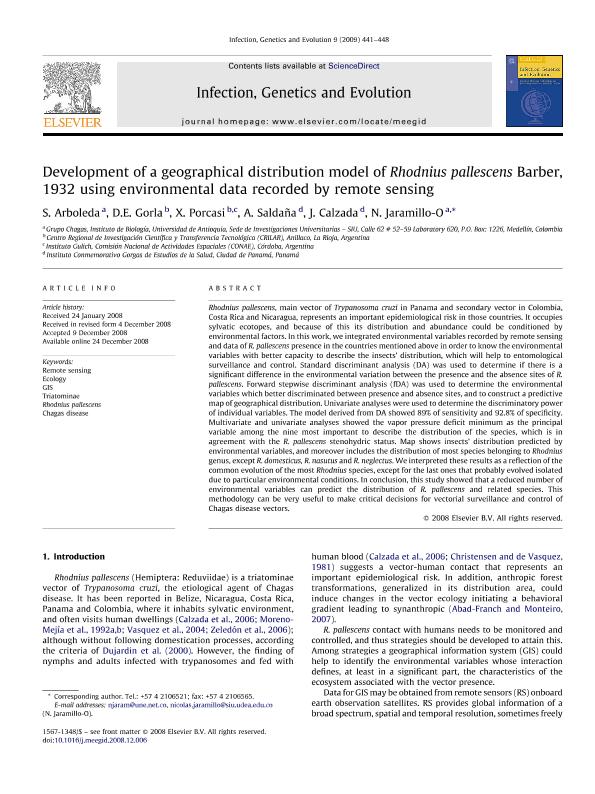Artículo
Development of a geographical distribution model of Rhodnius pallescens Barber, 1932 using environmental data recorded by remote sensing
Arboleda, Sair; Gorla, David Eladio ; Porcasi Gomez, Ximena
; Porcasi Gomez, Ximena ; Saldaña, Azael; Calzada, Jose; Jaramillo, Nicolas
; Saldaña, Azael; Calzada, Jose; Jaramillo, Nicolas
 ; Porcasi Gomez, Ximena
; Porcasi Gomez, Ximena ; Saldaña, Azael; Calzada, Jose; Jaramillo, Nicolas
; Saldaña, Azael; Calzada, Jose; Jaramillo, Nicolas
Fecha de publicación:
07/2009
Editorial:
Elsevier Science
Revista:
Infection, Genetics and Evolution
ISSN:
1567-1348
Idioma:
Inglés
Tipo de recurso:
Artículo publicado
Clasificación temática:
Resumen
Rhodnius pallescens, main vector of Trypanosoma cruzi in Panama and secondary vector in Colombia, Costa Rica and Nicaragua, represents an important epidemiological risk in those countries. It occupies sylvatic ecotopes, and because of this its distribution and abundance could be conditioned by environmental factors. In this work, we integrated environmental variables recorded by remote sensing and data of R. pallescens presence in the countries mentioned above in order to know the environmental variables with better capacity to describe the insects' distribution, which will help to entomological surveillance and control. Standard discriminant analysis (DA) was used to determine if there is a significant difference in the environmental variation between the presence and the absence sites of R. pallescens. Forward stepwise discriminant analysis (fDA) was used to determine the environmental variables which better discriminated between presence and absence sites, and to construct a predictive map of geographical distribution. Univariate analyses were used to determine the discriminatory power of individual variables. The model derived from DA showed 89% of sensitivity and 92.8% of specificity. Multivariate and univariate analyses showed the vapor pressure deficit minimum as the principal variable among the nine most important to describe the distribution of the species, which is in agreement with the R. pallescens stenohydric status. Map shows insects' distribution predicted by environmental variables, and moreover includes the distribution of most species belonging to Rhodnius genus, except R. domesticus, R. nasutus and R. neglectus. We interpreted these results as a reflection of the common evolution of the most Rhodnius species, except for the last ones that probably evolved isolated due to particular environmental conditions. In conclusion, this study showed that a reduced number of environmental variables can predict the distribution of R. pallescens and related species. This methodology can be very useful to make critical decisions for vectorial surveillance and control of Chagas disease vectors.
Palabras clave:
Chagas Disease
,
Ecology
,
Gis
,
Remote Sensing
,
Rhodnius Pallescens
,
Triatominae
Archivos asociados
Licencia
Identificadores
Colecciones
Articulos(CRILAR)
Articulos de CENTRO REGIONAL DE INV. CIENTIFICAS Y TRANSFERENCIA TECNOLOGICA DE ANILLACO
Articulos de CENTRO REGIONAL DE INV. CIENTIFICAS Y TRANSFERENCIA TECNOLOGICA DE ANILLACO
Citación
Arboleda, Sair; Gorla, David Eladio; Porcasi Gomez, Ximena; Saldaña, Azael; Calzada, Jose; et al.; Development of a geographical distribution model of Rhodnius pallescens Barber, 1932 using environmental data recorded by remote sensing; Elsevier Science; Infection, Genetics and Evolution; 9; 4; 7-2009; 441-448
Compartir
Altmétricas



